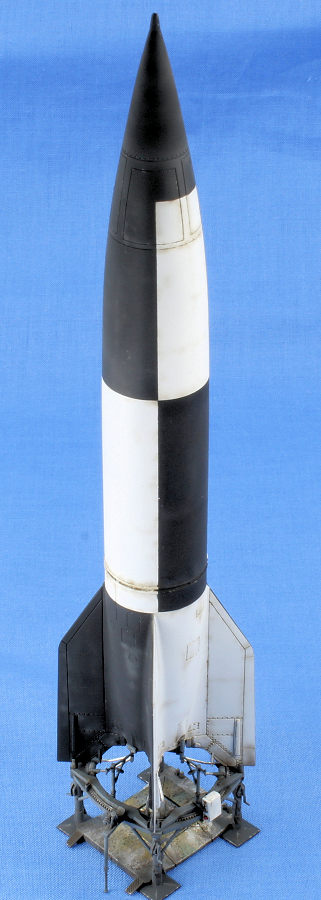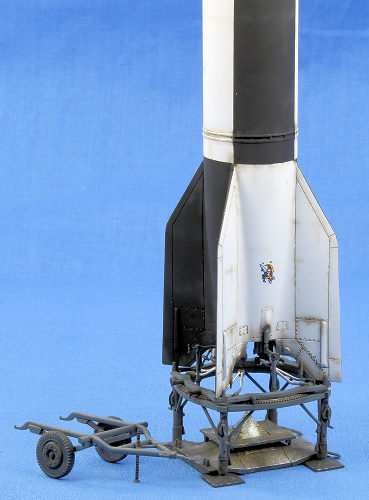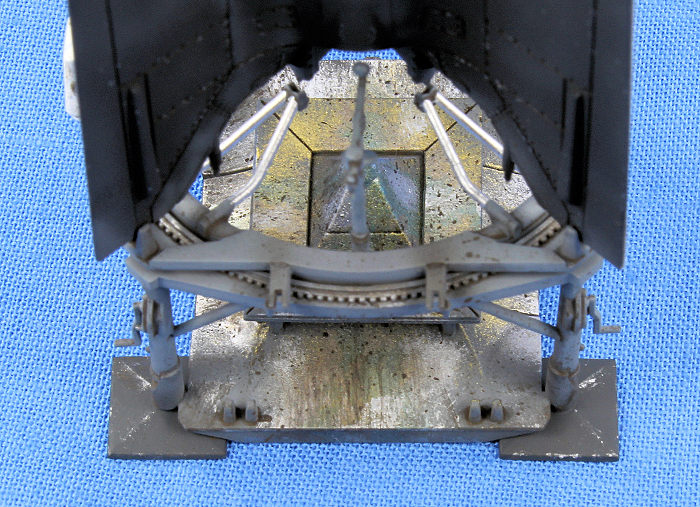 Essentially
a tube with some fins, the V-2 Rocket may not be the most exciting subject
to build a model of. What it lacks in charisma however it makes up for with
historical significance and enduring controversy. Fired from bases in
occupied Holland and western Germany, the V-2 would soar some 50 miles above
the earth before nosing over for its target, usually either London or
Antwerp. The world’s first operational ballistic missile, it ushered in the
age of the ICBM – and with it the threat of nuclear annihilation that has
been with us ever since.
Essentially
a tube with some fins, the V-2 Rocket may not be the most exciting subject
to build a model of. What it lacks in charisma however it makes up for with
historical significance and enduring controversy. Fired from bases in
occupied Holland and western Germany, the V-2 would soar some 50 miles above
the earth before nosing over for its target, usually either London or
Antwerp. The world’s first operational ballistic missile, it ushered in the
age of the ICBM – and with it the threat of nuclear annihilation that has
been with us ever since.
In the 1920s and 30s research into rockets was underway around the world. When the Nazis came to power in the mid-30s they soon grasped the military potential for long range guided missiles, and the rocket program was expanded considerably. A secret research base was established on the Baltic coast with Walter Dornberger and Werner von Braun, years later to become household names during the Space Race, put in charge. A series of rockets were developed and tested with the A-4 rocket, the progenitor of the V-2, emerging from the pack. It was decided to arm the rocket with a one ton warhead, give it a range of 170 miles, and keep it small enough to be transportable by road vehicles. Construction began in 1938 with the goal of having the system ready for the field in 1943.
Essentially a brand new weapons system, several technical problems had to be solved before the rocket flew reliably. The date of the first successful launch is generally given as October 3, 1942 when the missile actually reached the edge of space, becoming the first manmade object to do so in the process. Despite that, subsequent launches generally failed more often than they succeeded until the fall of 1943 when the majority of the missile’s problems were worked out. Hitler was impressed enough by that initial flight however to order the V-2 into production late in 1942.
Combat units were formed to field the rocket in late 1943, but the first official combat launch of the V-2 was not until September 7, 1944 when two were launched at Paris, recently liberated by the Allies. Both fell back onto the launch pad and crashed, complete failures. Nonetheless the problems were soon solved and that fall saw a steady stream of successful launches against London and Antwerp, the citizens of which now having to contend with yet another wave of violence from above.
There was no defense against the V-2s. Unlike the
V-1s which could be seen, heard and even intercepted, the V-2s, plunging
down at supersonic speed, could not be intercepted or even detected until it
was too late. The missile would impact without warning, which made the
weapon all the more terrifying. One minute life was carrying on as normal,
the next a city block had been blown apart, a huge crater in the ground,
buildings demolished, broken water and gas mains spewing their contents
everywhere, and of course, dead and wounded people and children, shattered,
maimed, those left alive trying to figure out what just happened. The
British government controversially maintained silence about the V-2s, not
wanting to give out any information that might be useful to the Germans, and
also not wanting to sew any more domestic fear than was necessary. Thus as
word spread about “some new bomb” or the “flying gas pipe”, nerves began to
fray, the fear of suddenly being vaporized constantly gnawing in the back of
one’s mind. Before the war airpower experts around the world believed that a
large bomber force could bomb a civilian population into submission and
force their government to sue for peace. These theories were proven wrong by
the English during the Blitz and the Germans throughout their ordeal, the
people always proving more resilient than previously thought. But the V-2
was different and seemed to be accomplishing that very effect. Many
Londoners testified during the winter of 1944-45 that this new threat had
them at their wit’s end - “Churchill or no Churchill.”
 One
wonders how the war would have played out if Hitler had the V-2 a few years
earlier.
One
wonders how the war would have played out if Hitler had the V-2 a few years
earlier.
The only real solution to the V-2 problem was to overrun their launching areas. By late 1944 and into 1945, with Allied armies pressing ever closer to Germany, the V-2s had to be pulled back from their Netherlands bases, effectively removing London from harm’s way. More rockets were fired at Antwerp, now a huge Allied supply base and therefore a high value military target. It was not until March 1945 that the last V-2s were fired, by which point Germany was beginning to collapse.
Some 6,000 V-2s were produced. Of those roughly 1,660 were launched at Belgium (Antwerp was targeted 1,610 times), and another 1,400 launched at England. An estimated 1,700 people were killed in Antwerp, while another 2,700 English civilians lost their lives.
The history of the V-2 has several other facets that my little article has not even touched on. Slave labor taken from concentration camps was used to produce the rockets, mostly in the Mittelwerk underground tunnel complex near Nordhausen. Ruthlessly treated by the SS, more laborers died in the production process than were killed by all of the V-2 explosions on Allied soil combined.
It is debatable whether the V-2 program was even worth it at all. Historians estimate it cost Germany 50% more than the Manhattan project, and it certainly had little if any military impact on the war. The V-2 did actually achieve something of non-violent, scientific significance – as mentioned above it was the first manmade object to reach outer space, a feat it accomplished in its October 1942 test launch when it passed the Karman line, the so-called boundary between the Earth’s atmosphere and outer space.
So the story of the V-2 has many sides, plenty of drama, and many layers to unwrap. It was truly, as we might say today, a game changer.
| THE KIT |
 Revell’s
1/72 V-2 is not their own, it was originally issued in 2013 by Special Armour.
This boxing features just the V-2, its launching stand, and a small cart
presumably used to transport the stand. There are two sprues of light gray,
finely molded parts, one small sheet of decals, and a full color instruction
book. Included in the instructions is a painting guide for 4 different missiles,
one the black and white checkerboard test missile pattern, two later camouflage
patterns, and a final version all in dark green.
Revell’s
1/72 V-2 is not their own, it was originally issued in 2013 by Special Armour.
This boxing features just the V-2, its launching stand, and a small cart
presumably used to transport the stand. There are two sprues of light gray,
finely molded parts, one small sheet of decals, and a full color instruction
book. Included in the instructions is a painting guide for 4 different missiles,
one the black and white checkerboard test missile pattern, two later camouflage
patterns, and a final version all in dark green.  Tamiya’s
Surface Primer was the first step for all three subjects. For the missile I
wanted to depict one of the earlier, black and white checkerboard patterns that
were painted on the test missiles. There seems to be some artistic leeway here
as photos show many different types of patterns. I first sprayed a coat of
Tamiya XF-2 Flat White on the whole rocket, then began masking sections off and
applying Tamiya XF-1 Flat Black that I lightened a bit by adding a drop or two
of White. The mix was lightened a bit further and applied randomly to create
some “splotching”, which is incidentally a possible side effect of a new drug I
saw advertised on TV.
Tamiya’s
Surface Primer was the first step for all three subjects. For the missile I
wanted to depict one of the earlier, black and white checkerboard patterns that
were painted on the test missiles. There seems to be some artistic leeway here
as photos show many different types of patterns. I first sprayed a coat of
Tamiya XF-2 Flat White on the whole rocket, then began masking sections off and
applying Tamiya XF-1 Flat Black that I lightened a bit by adding a drop or two
of White. The mix was lightened a bit further and applied randomly to create
some “splotching”, which is incidentally a possible side effect of a new drug I
saw advertised on TV.